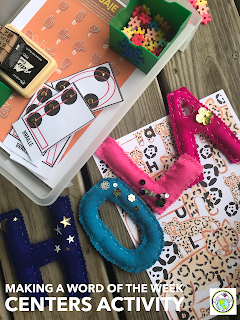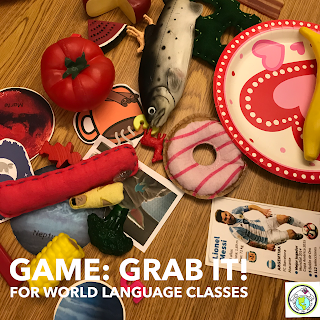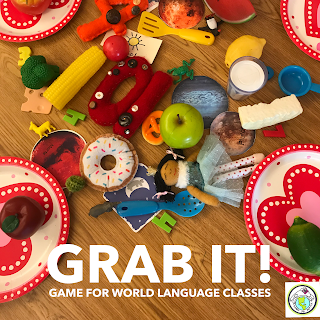CENTERS THAT FOSTER PRE AND EARLY LITERACY SKILLS are a focus for my classes, with many different ways for this to manifest. One set of activities I include are 'word of the week' or 'word of the day' activities, which typically involve one or more words that kids re-create in some fashion, either with magnetic letters, gems, beans, popsicle sticks, to name a few. After reading this
blog post on Kindergarten centers, I am working to adopt her centers system with some tweaks to better fit my elementary Spanish classes.
TO THAT END, I AM IN THE PROCESS OF CREATING CENTERS KITS which kids can take to a seat and engage with-including Word of the Week activities.
HERE IS AN EXAMPLE with the word HOLA:
In the tray goes a series of materials that can be used to spell out the word HOLA, with differentiation based on grade level (I'll add more to this below). In this instance, the prompt is to spell the word FIVE different ways using the materials in the tray.
MATERIALS THAT COULD GO IN THE TRAY:
-Felt or other 3D letters
-Braille letters
-Magnetic letters
-Manipulatives such as connectors, Legos, popsicle sticks, unifix cubes, counters, etc to create the letters
-Circle the letters in a text
-Sign Language posters
-Mini stamps
-Scrabble Letters
-Letter blocks
-Letter beads
-Word cards and beans, buttons, gems or other small objects to "trace" the letters
-Etch A Sketch
-Tracing cursive text
to name a few!
WHILE IT SEEMS TO ONLY FOCUS ON ONE WORD, the idea behind these activities is to reinforce early literacy skills in a hands-on manner (note I try to have a mix of different types of texture, movement, etc to further engage kiddos.) while at the same time giving practice to Novice Low word bank development. What I have been finding over the last few years since the pandemic hit is low capacity for risk taking and high mental load activities amongst many students. These 'spell it' activities fill a gap, allowing for low mental load practice in a variety of ways.
YOU CAN ALTER THIS TRAY by having more than one word to spell-so instead of the prompt being 'spell Hola five times', it could be 'spell Hola, Adiós, gracias, por favor'. Or a set of color words, fruit, etc. For older students and/or students with greater proficiency, you can differentiate by giving them a picture prompt instead of a word card so they need to actually spell the word. You can give them a set of words that then become a short sentence or a pattern sentence with multiple possibilities (Yo veo un gato, un perro, una manzana, una flor...). Changing the modality of input & practice is yet another way we can engage kids!
A NOTE FOR THOSE OF YOU ON A CART! I was on a cart and between two buildings for 13 years, so I know that set ups like these are more challenging when you don't have a classroom. One way to organize this is to use large pouches or bags that can all be stored and transported in a bin, and then easily passed out to kids. Using small tins or containers to house little items like counters or magnetic letters within the larger bag provides greater organization and storage. Here is a picture of the zippered pouches I bought on Amazon:
How do you set up word work centers? Share in the comments! :)















